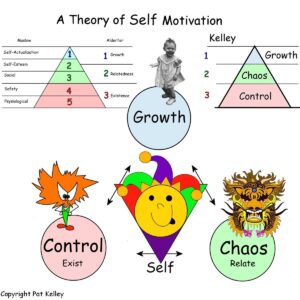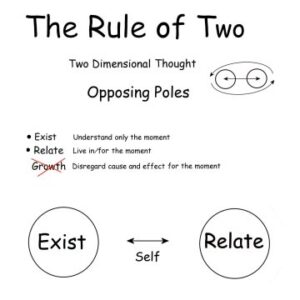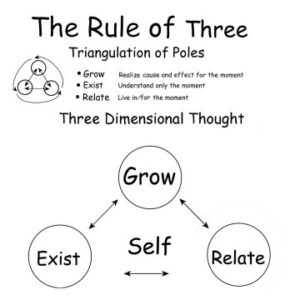 Maslow’s “A Theory of Human Motivation,” explains throughout life, we collect volumes of assumptions and stereotypes learned through education and personal experience. U name it. Assumptions are everywhere around us, in everything we do and say. Who has the time to research every little thing as it happens?
Maslow’s “A Theory of Human Motivation,” explains throughout life, we collect volumes of assumptions and stereotypes learned through education and personal experience. U name it. Assumptions are everywhere around us, in everything we do and say. Who has the time to research every little thing as it happens?
Both assumption and stereotype are survival mechanisms. Survival depends upon past learned assumptions.
Stereotyping fast-tracks the response time
BUT
Assumption and stereotypes may assist and interfere with interpersonal interactions.
To Paraphrase Maslow:
The function of education is to neutralize apparent dangers through knowledge.
We are not afraid of thunder because we know something about thunder.
- Assumption: belief that something is true based on tenuous or no evidence
- Stereotype: positive or negative, oversimplified image or idea often based on assumptions
Survival Logic Dictates Assume
- survive if you believe XYZ today
- XYZ ensures survive tomorrow
- XYZ reinforced accurate assumption
Assumptions develop and are stored in memory as stereotypes along side associated thoughts and memories.
Once an assumption is formed the brain goes into auto pilot until a bonafide V8 forehead slap paradigm shift occurs.
None of us are the same person we were 20 years ago or 3 years ago, or last month. We hope to be a different person tomorrow because that means we would have learned a thing or two about existence and our importance to the universe or lack thereof. But it is not easy.
Synergetic media targets on multiple levels, visual, audio, sound, illusion to effectively reinforce or weaken the image or idea in our pointy little heads.
Hopefully we all have changed many assumptions and stereotypes throughout the course of our lives. In addition to the BIG ones media constantly throws in our faces:
 Adoption, Sex, Marriage, Men, Children, Women, Abortion, Religion, Race, Politics
Adoption, Sex, Marriage, Men, Children, Women, Abortion, Religion, Race, Politics
Assumptions and stereotypes are easy targets for constant bombardment by media, Internet, TV, radio, books, advertising, movies, film industry, type casting, sound track, wardrobe, music, simplistic plots… I could go on …
Stories, folklore, myths & legends, movies, TV and videos all ascribe assumed qualities and characteristics to groups of people.
- Off-key, sad music changes to melodious happy
- Drum beats and flute music – American Indians
- wise seer, usually old, blind or lame and harmless
- chopsticks, gongs
- digeriedoo western
- southern theme banjo – car chases, bar fights
- ignorance through accents – the souther the accent the stupider the acting charactor
Media Advertising & ideologies push and pull to reinforce and admonish stereotyping assumptions.
Media treats assumption & stereotyping as though they are two opposing and separate cause and effect entities:
- right vs left
- bad vs good
- fear vs safety
The only things that can change the cycle are:
- Awareness
- Curiosity
- Desire to learn
 Easy right?
Easy right?
Be Your Own Joker. Call on yourself to task, to question old habits and paradigms.
Break the “either/or” two-pronged pattern of 2-D Thinking
- right vs wrong,
- left vs right,
- fear vs safe
Rule of Three
Apply Maslow’s Theory of Human Motivation
- Growth,
- Relatedness,
- Existence
 Test your paradigms:
Test your paradigms:
Jot down some first impressions that comes to mind in the columns for each name listed below.
Research to determine whether these assumptions are true or baseless, oversimplified stereotypes.
Print Assumptions & Stereotype
Print and hand out to participants – Enter the first impression they have with each word on the list. Discuss.
In column 2 (Assumptions) quickly jot down your first impressions of each word listed in the first column. When you are through listing all your assumptions, do some research for each description to determine which of your assumptions are true and just and which are baseless, oversimplified stereotypes.
| Name | Assumption | Stereotype | True or False? |
|---|---|---|---|
| Mortician | |||
| Dog Walker | |||
| Pedestrian | |||
| Bicyclist | |||
| Accountant | |||
| Female Pilots | |||
| Programmers | |||
| Nurse | |||
| Poor People | |||
| Flight | |||
| Attendant | |||
| Hair Color | |||
| Tattoos | |||
| Homemaker | |||
| Artist | |||
| Truck Driver | |||
| Scientist | |||
| Elderly | |||
| Firemen | |||
| Secretary | |||
| Fashion Model | |||
| Cowboy | |||
| Mechanic | |||
| Prison Guard | |||
| Sales Person | |||
| Rich People | |||
| Veterans | |||
| Teenagers | |||
| Librarian | |||
| Welder |
